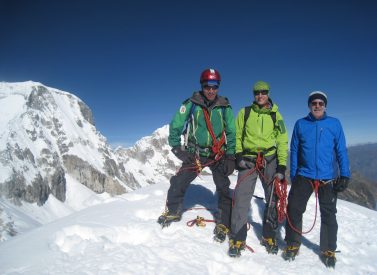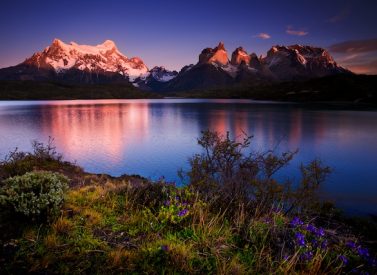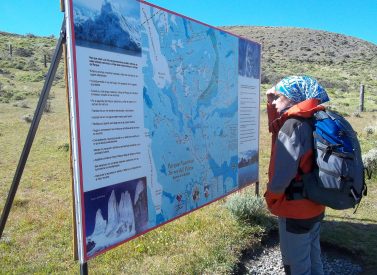
The Huemul Circuit Trek, El Chalten
Hike El Chaltén’s Huemul Circuit trek through remote Los Glaciares National Park.
The Huemul Circuit trek invites the hiker to a challenging and epic hike through some of the most remote parts of Argentina’s Los Glaciares National Park.
Effort is rewarded equally by fantastic mountain views throughout the Huemul Circuit, pronounced way-mool. Hikers walk about 43 miles/70km from the El Chaltén start point to the finish on the banks of Lago Viedma. But remember that this is an expedition; participants carry all their gear, including a sleeping bag and mat and the (provided) tent.
A true highlight is the incredible views of the second-largest non-polar ice mass in the world, the Southern Patagonian Ice Field, and hiking on the Túnel glacier. Walkers also enjoy a journey that takes in forests, meadows, exciting river crossings, and glacial moraines.
We’ll cross the Viento and Huemul Passes and the River Túnel by zipline with a thrilling Tyrolean traverse. By camping wild, including next to bays replete with floating icebergs, you’ll experience Patagonia at its rawest and most authentic.
We even traverse the enormous Viedma glacier to its edge, where it collapses into Lago Viedma. Prepare yourself for stunning sunsets and beautiful colours, from the glistening Lago Viedma to the blue shades of the Patagonia Ice Cap. Remember, there’s no other trek like the Huemul Circuit in El Chaltén.
How Far Is the Huemul Circuit?
The Huemul Circuit is around 43 miles/70km in length. We complete the trek in four days, weather permitting.
What Is the Elevation Gain of the Huemul Circuit?
The overall elevation gain of the Huemul Circuit trek is around 1,750-1,800m/5,742-5,905ft over four days of trekking.
The trek’s highest point is the Windy Pass (1,400m/4,593ft), or Vienta Pass in Spanish. We reach the Windy Pass on day two. It’s not high enough that altitude becomes an issue.
Map of the Huemul Circuit Route
Below is a map of the four-day Huemul Circuit trekking map in Los Glaciares National Park. The route starts in El Chaltén, with this outline itinerary:
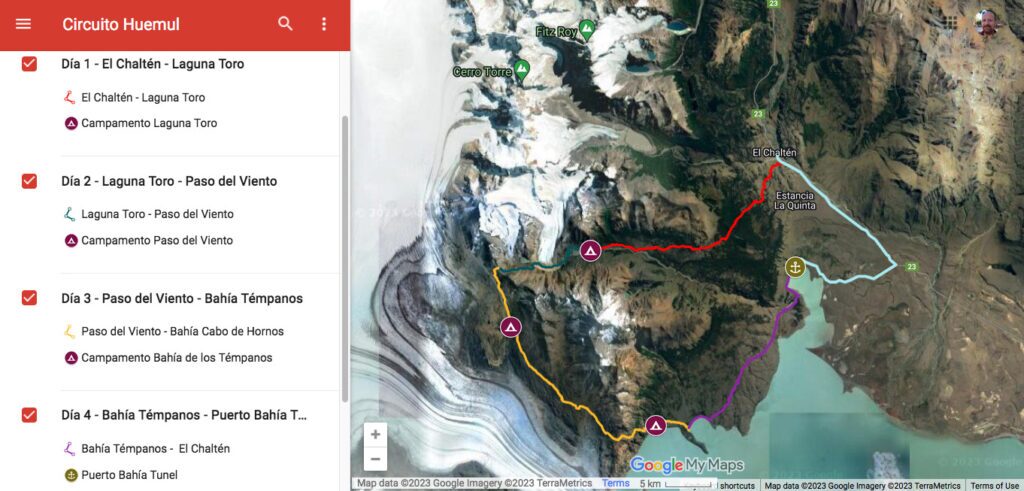
Itinerary
Day 1: Trek to Laguna Toro and camp (10 miles/16km)
Day 2: Hike up to the Viento Pass (Windy Pass), camp (10 miles/16km)
Day 3: Trek up and over the Huemul Pass, camp (11.5 miles/18km)
Day 4: Hike out to El Chaltén, tour ends. (9.5 miles/15km)
What Are the Camps Like on the Huemul Circuit?
The Huemul Circuit trek visits remote areas without permanent campsites. We work as an expedition team, carrying all our equipment and food and setting up and breaking camp daily.
Most campsites are strategically placed to be out of the wind. Drinking water is usually collected from rivers, lakes, or glacial melt. Some camps have primitive toilets, while others have no outhouses. Every camp has a designated area for ablutions. People must carry their waste out with them.
Everyone must carry their own kit, including part of the tent, and communal food (5-6kg per person) to be eaten throughout the trip.
Trip Highlights
Print Share Download as PDF-
Amazing views of the South Patagonia Ice Cap
-
Wild camping next to iceberg-laden lakes
-
Hike on the Túnel Glacier
-
Beautiful lookouts over glaciers, moraines, and forests
-
Traverse the Viedma Glacier
-
Tyrolean traverse over River Túnel
The trip was great. We had perfect weather - 8 days with no precipitation and sunshine for at least a few hours on most days. It was a tough hike, but completely spectacular.
Highlight was getting to the Cerro El Torre valley and camping there for two nights under the completely spectacular massifs there. The skies were clear and we could just spend hours sitting out there admiring Cerro El Torre and the other peaks.
Ven Seshardi, Canada, Ice Field Trek
Full Itinerary
Day 1: Trek El Chaltén to Laguna Toro, camp (L,D)
Please note: There is a pre-trek briefing in El Chaltén the day before the trek starts.
We leave El Chaltén early in the morning, taking the trail towards Laguna Toro. The path takes us through open fields and beech forests with occasional glimpses of Cerro Torre and Fitz Roy.
The Cerro Huemul massif begins to fill the view, and we must descend to reach our campsite at Laguna Toro. Recent rain or warm weather may have caused glacial melt, meaning some knee-high river crossings.
Campamento Laguna Toro (Toro Camp) is in a sheltered spot from the wind.
Hike length: 10 miles/16km
Trekking time: 6-7 hours
Elevation: +600m (1,970ft) / -400m (1,312ft)
Meals included: Packed lunch, dinner
Accommodation: Wild camping
Day 2: Zipline, Viento Pass, South Patagonia Ice Field, camp (B,L,D)
Morning routines mean breakfast and breaking camp together before setting off trekking.
We must cross the Túnel River today, and we do that via a zipline called a Tyrolean traverse. People and kit clip onto a zipline and make their way over the cold waters of the Túnel so we can continue the Huemul Circuit trek.
One challenge is completed, and another one comes along. It’s a long uphill pull from the crossing to the Viento Pass, or Windy Pass, skirting across the Lower Túnel Glacier. The Windy Pass (1,400m/4,593ft) is famous for gales and unrivalled views over the South Patagonia Ice Field, the Mariano Moreno mountain range, and the Viedma Glacier.
The reward is worth the effort.
We’ll descend to the site of a Refugio, way up in the mountains, appropriately called the Refugio Paso del Viento, or shelter from the windy pass. Here, we wild camp.
Hike length: 10 miles/16km
Trekking time: 6-7 hours
Elevation: +800m (2,624ft) / -400m (1,312ft)
Meals included: Breakfast, packed lunch, dinner
Accommodation: Wild camping
Day 3: Viedma Glacier and Huemul Pass (B,L,D)
Today is a spectacular day, accompanied by the enormous Viedma Glacier we trek above in the morning. This vantage point affords fantastic views, with mountain lakes complementing the scenery. There is a fair amount of descent, so prepare the knees and allow landscapes to distract you.
The downhills stop roughly about lunchtime. Process the energy well because it’s an uphill next, up and over the Huemul Pass, the pass the trek is named after. This is the last significant climb of the trip. Once we crest the pass, we’ll say goodbye to the South Patagonia Ice Field and tackle another steep descent to our campsite, the aptly titled Bay of Iceberg.
This sheltered camp is next to a lake replete with floating icebergs, a magical sight. Take time to explore the shore and get some incredible photographs, especially if there is a colourful sunset.
Hike length: 11.5 miles/18km
Trekking time: 9 hours
Elevation: +400m (1,312ft) / -800m (2,624ft)
Meals included: Breakfast, packed lunch, dinner
Accommodation: Wild camping
Day 4: Cross the Túnel River, arrive El Chaltén (B,L)
As we break camp, we leave behind the extreme undulations of the previous three days. Our backpacks will feel lighter now that most of the provisions have been consumed as we walk back towards El Chaltén.
The Patagonia steppe is the background to today’s walk, which is relatively flat. We cross the Túnel River once more, using the zipline. You’ll see our transport vehicle waiting on the other side of the river, ready to take us to El Chaltén, a rare incentive.
The Huemul Circuit trek is complete, and we take the short drive back to town.
Hike length: 9.5 miles/15km
Trekking time: 6 hours
Elevation: +200m (660ft) / -200m (660ft)
Meals included: Breakfast, packed lunch
Accommodation: Not included
Prices From $1,780 / £1,447 per person
What's Included?
Meals and transfers as listed, bilingual mountain guide, Huemul Circuit entry permits, communal camping kit (tent, stove, plates, cutlery, etc.), technical equipment for the zipline crossings, VHF/Satellite communication
What's Not Included?
Flights, accommodation in El Chaltén, sleeping bag, sleeping mat, tips, insurance, personal items, extra snacks, transportation between El Calafate and El Chalten (we can arrange this at extra cost)
Accommodation
Wild camping.
Some camps have primitive toilets, while others have no outhouses. Every camp has a designated area for ablutions. People must carry their waste out with them.
On the trek, we use strong, two man mountain tents, which you help to carry. There is no dining tent on this trek, so any meals are served al fresco or in your tent.
Tour Staff
We work with local, expert fully-qualified Argentinian guides, some with +20 years’ experience of hiking and trekking this route and in this region.
You can hire a porter (extra cost) to carry your personal kit to lighten your load.
Meals
Almost all dietary requirements can be catered for – please enquire.
For the expedition, food will be prepared by your guides, often in difficult conditions. The group carries all of the food for the entire route, and so while nutritious, it can be basic. Be prepared – this is an expedition.
Please bring some snacks of your own, as those available in Chalten are expensive and not always the best quality.
Meals will be plentiful and will feature porridge, cereals and hot drinks in your tent for breakfast (there is no dining tent).
Lunch will often be crackers, cheese, meats etc. Evening meals can feature instant mash, rice, pasta etc.
Activity Level
We have classified this as a tough trek, due to its expedition-type nature. Extreme weather conditions can make the going tough and previous experience of trekking and camping in winter conditions would be beneficial.
This is an expedition and everyone helps to carry communal kit and food. You will carry a heavy backpack they may be 15-25kg at the start (it get lighter as the trips continues as the food being carried gets eaten).
A very good level of fitness is necessary, as well as a flexible attitude. The itinerary may change day to day, as well as camp sites and hiking plans.
Huemul Circuit Difficulty Rating
This programme is an expedition and suits fit and adventurous hikers looking to challenge themselves. Participants require trekking and camping experience (wild camps) to help set up and break camp.
Everyone carries their own kit, including a sleeping bag, mat, and a portion of the group’s food supplies. Trekkers must be used to carrying heavy backpacks over multiple days. Weather can be inclement in this remote area.
Huemul Circuit Tyrolean Traverse
There are two Tyrolean traverses to tackle to complete the Huemul Circuit trek, both crossing the Túnel River.
Our guides help you clip in and explain how to move for a successful crossing. For many people, this traverse over the water below is one of the highlights of the Huemul Circuit.
Practical Information
Introduction to Patagonia
For most people, Patagonia evokes a vast, windblown plateau, jagged mountains and the life of the gauchos.
The steppe that occupies much of southern South America is only one aspect of a magical region, jam-packed with amazing and contrasting landscapes.
Patagonia (latitudes 40°-55°, approximately) embraces a vast portion of southern Chile and Argentina, from the Rio Colorado in the north, to Tierra del Fuego in the south.
For convenience, we have divided the region into three zones: the Lakes District of northern Patagonian, central Patagonia and southern Patagonia.
Kit list
Good kit is vital for every trip.
Book with Andean Trails and get 15% off Páramo’s fantastic ethical and high performance outdoor gear.
When planning for the extreme climatic conditions encountered on the Huemul Circuit, layering is the most practical and versatile clothing system. It’s worth remembering that our clothing keeps us warm by retaining and isolating the heat we ourselves create.
To best maintain body heat, several layers of lightweight, warm and quick-drying clothing are far more efficient than one or two thick layers.
Layers should have the following qualities:
- Breathability (able to wick away the humidity produced by sweat);
- Isolation (able to keep in the warm air our body produces); and
- Impermeability (able to impede the passing of wind and water).
First (base) layer: This layer wicks the sweat away from our skin, thus helping keep the body dry and warm. To this end, synthetic fabrics such as polypropylene should be used.
Mid layers: These isolating layers should also be synthetic (e.g. the known polar linings such as polartec or windblock, which are light and insulate twice as well as wool). Very important layers for retaining body heat.
Outer layer / shell: Finally, the vital layer which protects us from climatic adversities. A breathable, wind-proof and waterproof anorak, such as Goretex.
Give plenty of thought to kit selection, and try to keep weight down. You carry everything, including a share of the group food (5-6kg), tents, etc, and you will carry your pack everyday which will be around 15-25kg, depending on how you pack.
Tyrolean traverse kit and tent is provided. camping equipment.
Below is a more detailed guide.
Feet
- 2 pairs synthetic inner socks (e.g. polypropylene, thermastat, coolmax)
- 2 pairs thick loop-stitch/wool socks for cold.
- Three to four-season leather boots.
- Gaiters (1 pair), optional
- Trainers/sandals, for city-wear, evenings at lower camps & river crossings.
Legs
- Base layer leggings (1-2 pair).
- Thick fleece leggings (or salopettes) (1 pair).
- Goretex-type over-trousers (or salopettes) (1 pair).
- Trekking trousers (1 pair).
- Shorts – wear sparingly in early stages at altitude, as sun burns.
Body
- Thermal base layer shirts (2).
- Microfleece mid-layer shirt (1).
- Shirt/T-shirt 1 or 2 for lower altitudes. Long-sleeved, collared shirt protects against sun.
- Fleece jacket or similar (1).
- Warm jacket (down or synthetic) with hood. For camp and upper slopes.
- Waterproof Goretex-type jacket.
- 1-2 sports bras/tanks (for women)
Head and neck
- Broad-brimmed sunhat, essential.
- Warm hat, fleece or wool. (N.B. Up to 30% of body heat can be lost through the head).
- Balaclava/full-face ski mask (1)
- Sunglasses with UV filter and nose and side-pieces.
- 1 pair of glacier compatible sunglasses (full coverage – ask salesperson if you are not sure) or ski goggles.
- Scarf for cold.
- Bandanna – to protect neck from strong sun.
Hands
For the extreme cold, we recommend a 3-layer scheme:
- 1 pair of Gore-Tex shell gloves
- 1 pairs of removable fleece glove liners
- Mittens allow you to keep the fingers together, and better conserve heat (though they also make it difficult to perform certain tasks).
Technical kit
- Large backpack (60-65 litres). Comfortable and with waterproof lining or cover.
- You will need another bag to store belongings left at hotel during expedition.
- Pair of telescopic trekking poles. (can be rented).
Other expedition kit
- Sleeping bag – a good warm bag (‘4-season’, minimum, down to -12°C) and liner will be necessary for camping.
- Sleeping mat.
- 60-65 litre backpack
- Headlamp
- Water bottle (a 1L Nalgene bottle is ideal)
- Thermos (to carry hot drinks), 0.5 to 1 litre
- Sun cream (SPF 35+ or more)
- Lip balm (preferably with sun protection)
- Personal hygiene products, including toilet paper and wet wipes and plastic bags to carry out ablutions.
- Mosquito/fly repellent
- Crocs or other comfortable footwear (waterproof) for camps
- Light down or warm synthetic jacket to stay warm at night
- Personal first-aid kit to include: painkillers, plasters (band-aids), moleskin, anti-biotic cream, after-bite (tiger balm), anti-diarrhoea tablets, throat lozenges, re-hydration salts & personal medication.
- Towel & wash-kit.
- Wet Wipes/antiseptic hand-wash cream.
- Penknife.
- Plastic bags ‘Zip-loc’ & tough bin liners.
- Camera and film / memory cards (take at least twice the amount you think you will need!).
- Book, e-book, mp3 player/iPod or other for free time.
- Binoculars.
- Spanish/English phrasebook.
- Extra snacks i.e. cereal bars or favourite chocolate bars.
All other non-personal trekking and camping equipment is provided, e.g. tents, cutlery etc.
Weather
Patagonia, the very southern tip of South America, has a four-seasons-in-one day climate.
Summer (Nov-March) see temperatures reach up to 20°C, when glorious light pours over the region for up to 18 hours. This is the best time to visit, nevertheless, spring and summer is also when the central and southern Patagonian regions sometimes get buffeted by strong, westerly winds.
Summer days in national parks can also bring sunny, windless conditions, and you may well find yourself hiking in shorts and t-shirt. Afternoons can be warm with lots of sunshine. (Note: Patagonian UV rays are very strong).
It is usually cool and windy all year round but seldom does the temperature fall below freezing point. Some days start with snow and end in balmy sunshine. It is always interesting, and can range from 10°C-20°C in the summer, although the wind can make it feel chilly.
Even in summer (Dec-Mar) you should come prepared to find cold, strong winds (up to 130 km/hr) and rainfalls. The summer’s average temperature is 11ºC/52ºF (24ºC max, 2ºC min). It has been known to snow in camps in summer!
In general, the further south you go, the cooler it gets and the further west you go – towards the Andes and Pacific coast – the wetter and less predictable the weather is. The further east – towards and across the Patagonian plateau – the drier and more stable.
Winter (May-Sept) visits to these southern areas are possible, but many hotels close and not all trips are possible. Daylight hours can be very short and temperatures typically range from -2°C in the winter.
The lack of visitors can greatly improve chances of seeing wildlife in parks such as Paine. Winds tend to die down.
On the South Patagonian Ice Field (average height, 1,500 metres), the appearance of lenticular clouds – signifying changing conditions – can translate into extreme winds (up to 150 kmh) and heavy snowfall. Here, summer pre-dawn temperatures commonly reach -20°C, with wind chill lowering temperatures even more. However, on sunny, windless summer days, you might get away with wearing just a couple of thin layers.
In Peninsula Valdes, it does not rain much in the region on an annual basis, summers are usually mild, and the temperature sometimes gets very hot (touching 30ºC) and then eases off in the evening. The area does get very windy at times, especially on the peninsula, and warm and water/windproof clothing is recommended.
If you head to Ushuaia, due to its extreme southern location, temperatures may remain chilly during summer (Oct-March) the use of plenty of warm layers of clothing. Winter and Antarctic visits will require extreme clothing.
ATOL holiday protection
Andean Trails has 25 years of experience of putting together the best South America holidays.
We pay a fee to the CAA for every licensable passenger we book since we hold an Air Travel Organiser’s Licence granted by the Civil Aviation Authority. In the unlikely event of our insolvency, the CAA will ensure that you are not stranded abroad and will arrange to refund any money you have paid to us for an advance booking.
We also offer ATOL (Civil Aviation Authority) protected holidays to give our customers peace of mind when booking and travelling.
When you buy an ATOL protected air holiday package from Andean Trails Ltd you will receive a Confirmation Invoice from us confirming your arrangements and your protection under our Air Travel Organiser’s Licence number 6275.
You can read more about ATOL, who is covered and what protections you have if not ATOL-covered, on our ATOL page.
What is ATOL?
The CAA’s ATOL scheme offers protection to your money and your holiday if you book with us. Not everybody is covered (see ‘Who is covered?’ for more), as you must purchase an ‘air package holiday’ with Andean Trails to be protected.
And ‘air package holiday’ is defined as including a flight and some ground services (hotel, transfer, trek etc). This is also known as an ‘ATOL-protected holiday’.
Who is covered?
To be covered by ATOL, you must book a flight and some ground services with us and be from the UK. If you are from the UK and only book ground services and no flights, you are not covered by ATOL (see below for more on how non-ATOL clients are covered).
If you are outside the UK and buy flights with us, you will be ATOL protected IF any of the flights booked with Andean Trails touches/stops in the UK at any point during your holiday package booked with us.
If you buy your flights elsewhere, please check with that agent if you are ATOL protected. Be careful with online flight purchases and make sure you know what protection you have, if any, before paying for flights.
Not all holiday or travel services offered and sold by us will be protected by the ATOL scheme. Please ask us to confirm what protection may apply to your booking.
For land only holidays not involving any air travel, in accordance with “The Package Travel, Package Holidays and Package Tours Regulations 1992”, all UK passengers booking with Andean Trails Ltd. are fully protected for the initial deposit and subsequently the balance of all money paid to us, arising from cancellation or curtailment of travel arrangements due to the insolvency of Andean Trails.
I’m not ATOL covered, what protection do I have?
If you are not ATOL covered, any payments you make to us go to a Trust account.
We can only access this money once your tour has been completed, meaning that if anything happens to Andean Trails Limited while you are on holiday, then your money is secure and you can either complete the trip or be able to make it home.
If you pay for your holiday with a credit card, some offer payment protection – please check with your cardholder.
You also should have cancellation protection written into your insurance (which we recommend you have at the time of booking) in case you need to cancel.
Available Dates
07th Oct 2025 - From $1780 / £1447.14
2025-26 price, per person, shared tent basis.Season: October to March
CONFIRMED for 2025: Nov 7-10
2026: Jan 3-6, Jan 7-10, Feb 25-28, Feb 26-March 1
Private departures, any date:
2-3 people: USD 2,155pp
4 people: USD 2,040pp
6 people: USD 1,940pp
A personal porter costs USD 900 in total, and will carry 15kg in total.

Dates & Prices
Prices From $1,780 / £1,447 per person
2025-26 price, per person, shared tent basis.
Season: October to March
CONFIRMED for 2025: Nov 7-10
2026: Jan 3-6, Jan 7-10, Feb 25-28, Feb 26-March 1
Private departures, any date:
2-3 people: USD 2,155pp
4 people: USD 2,040pp
6 people: USD 1,940pp
A personal porter costs USD 900 in total, and will carry 15kg in total.
Can’t find what you’re looking for? Get in Touch
+44 (0)131 378 5593
+44 (0)131 554 6025



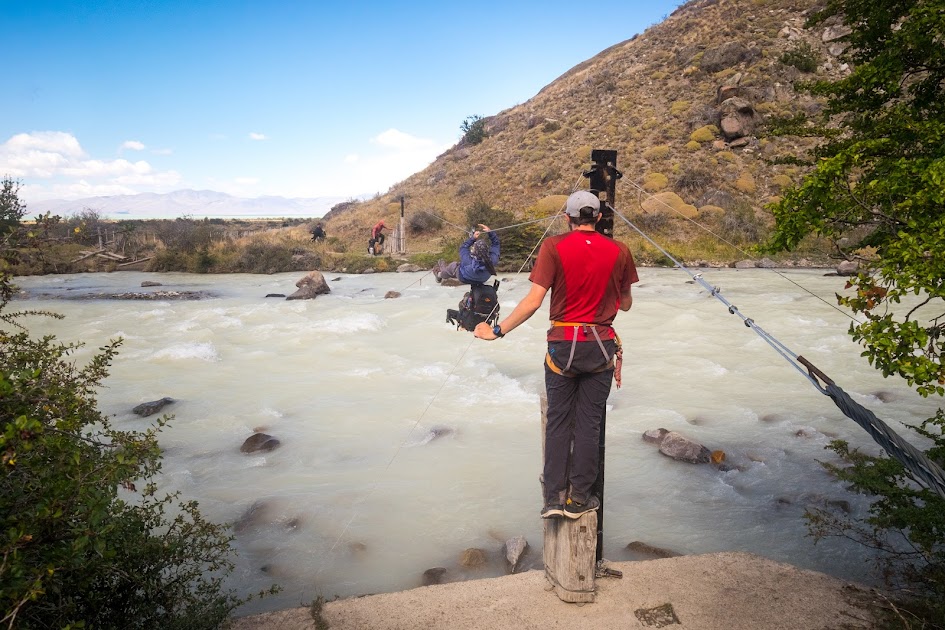
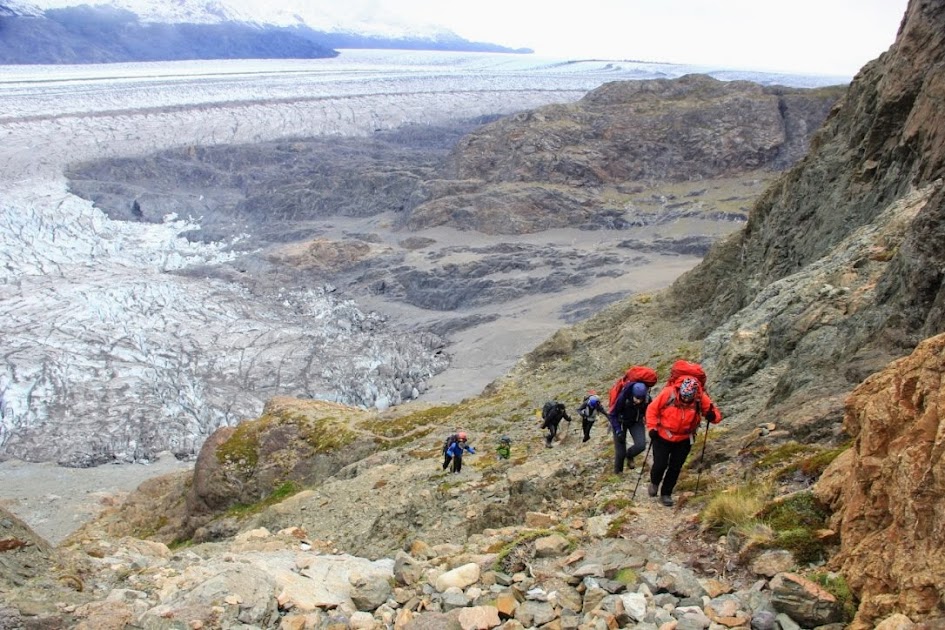
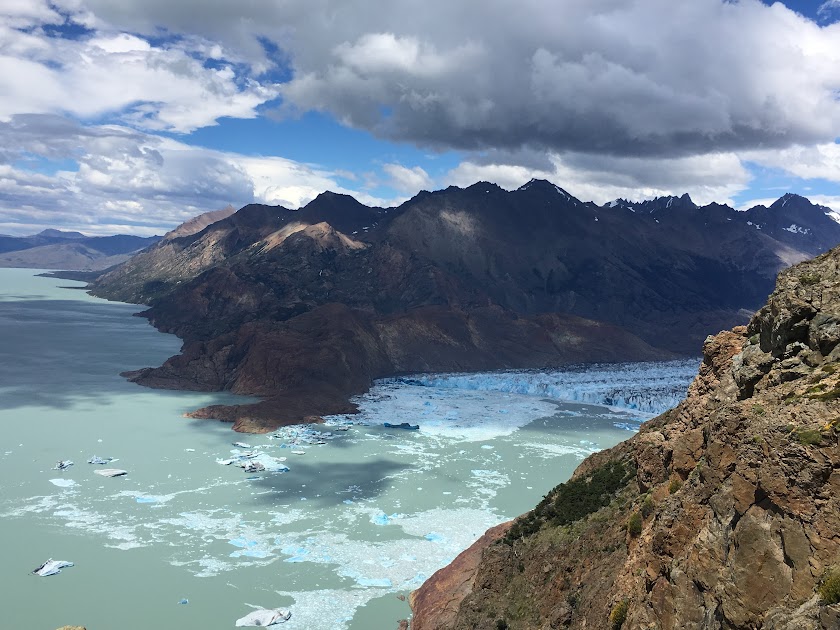
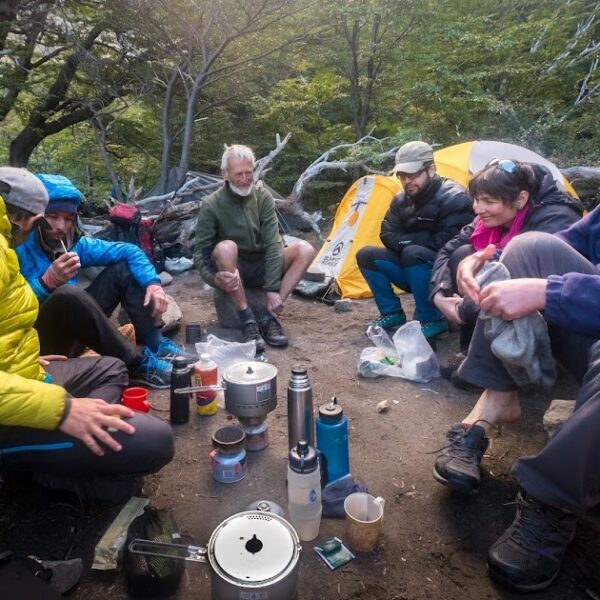
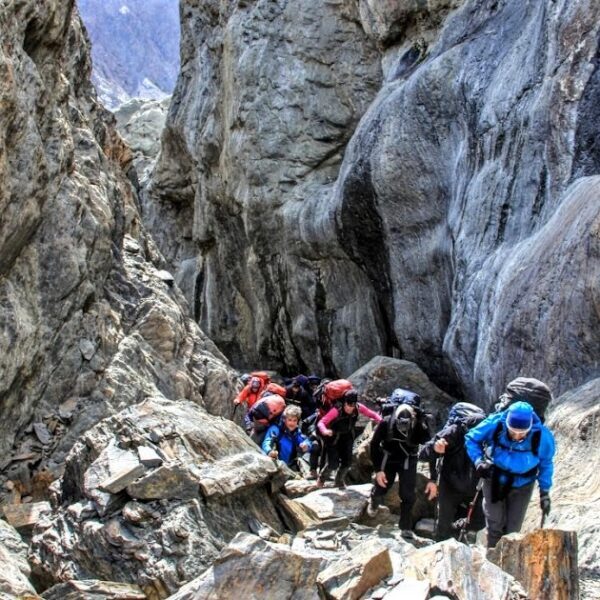
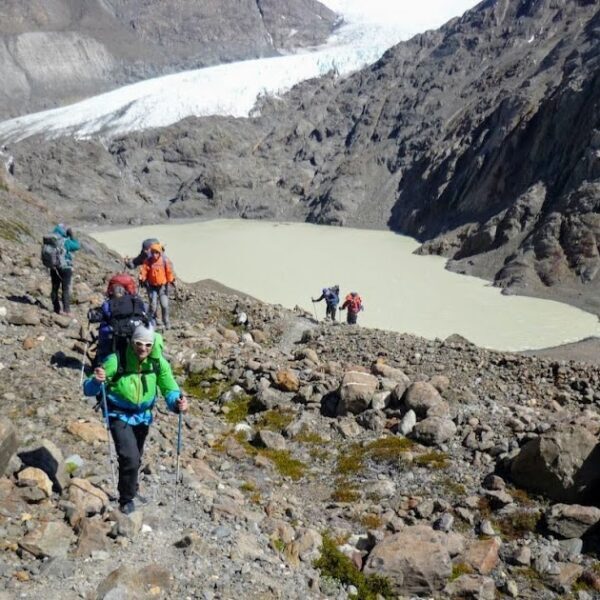
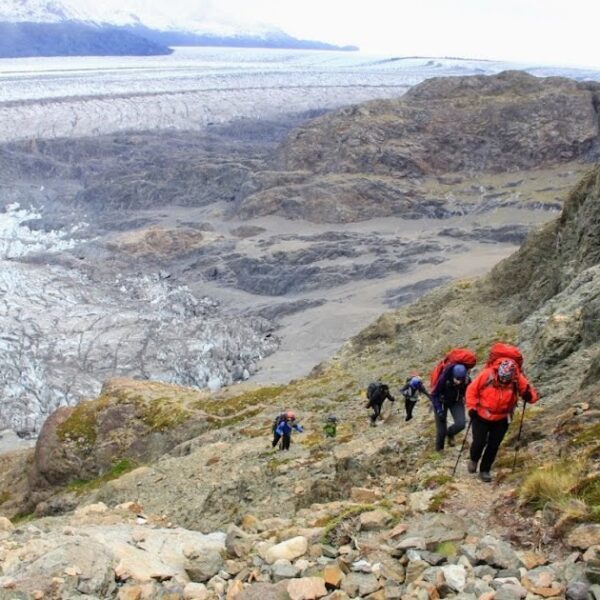
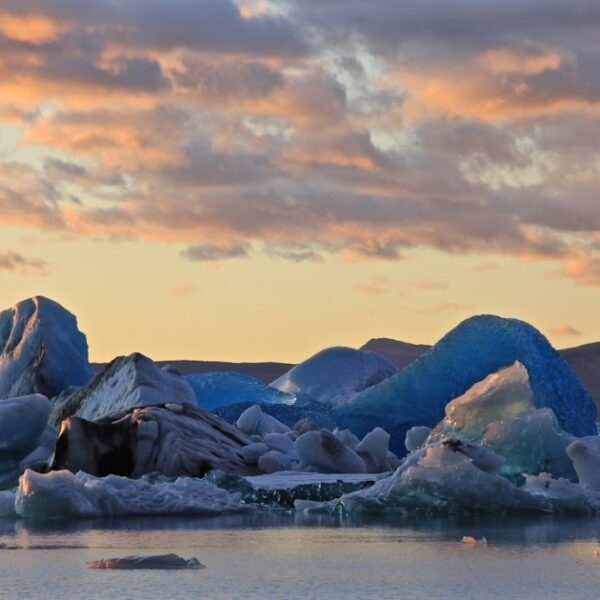
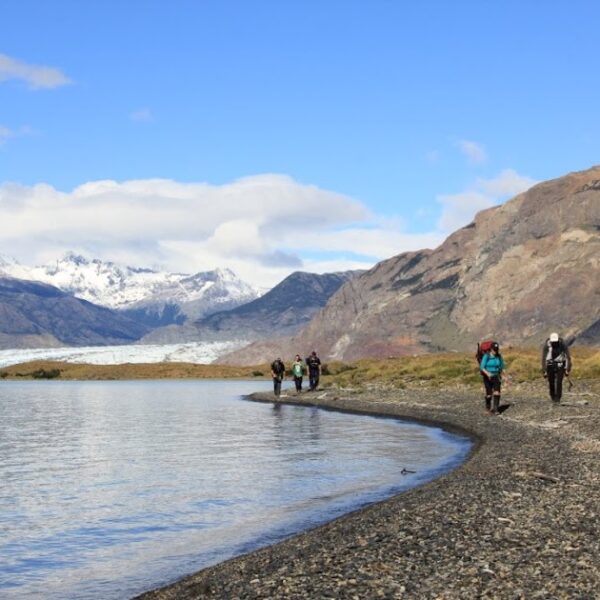
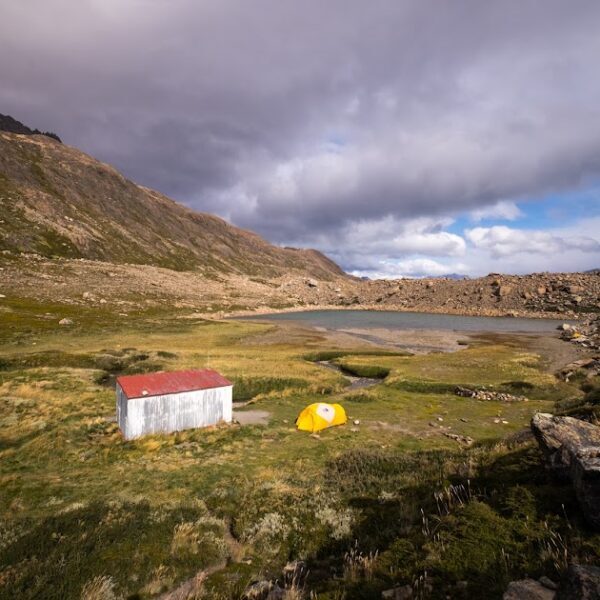
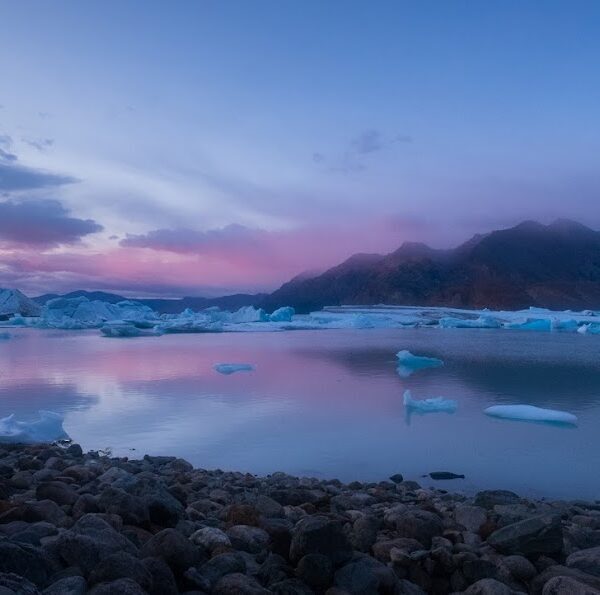
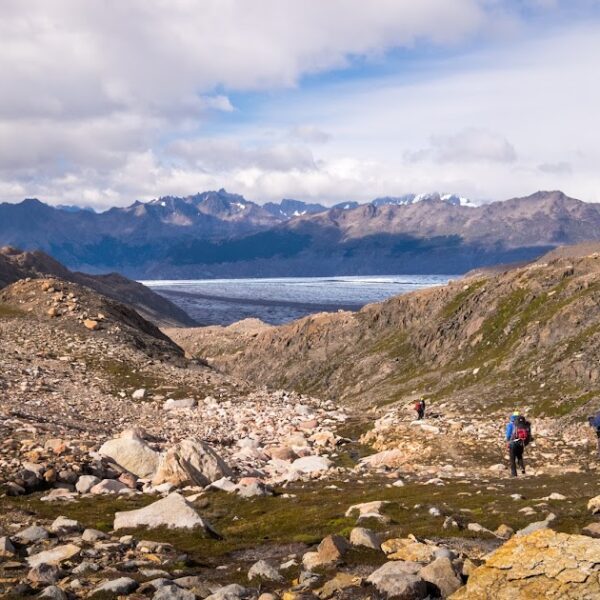
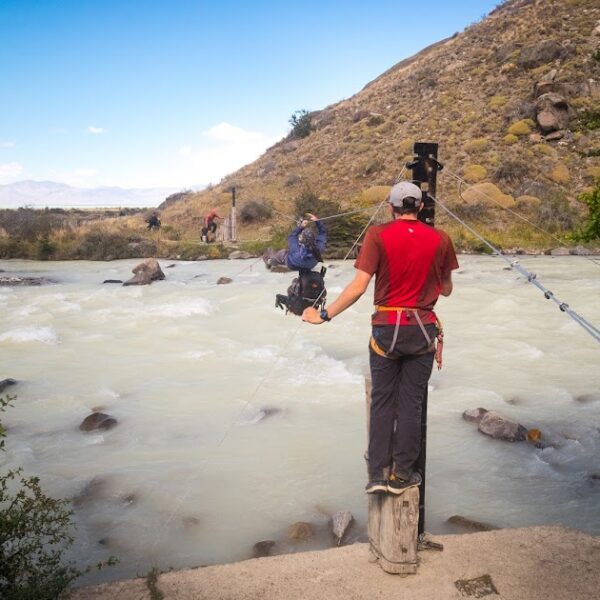
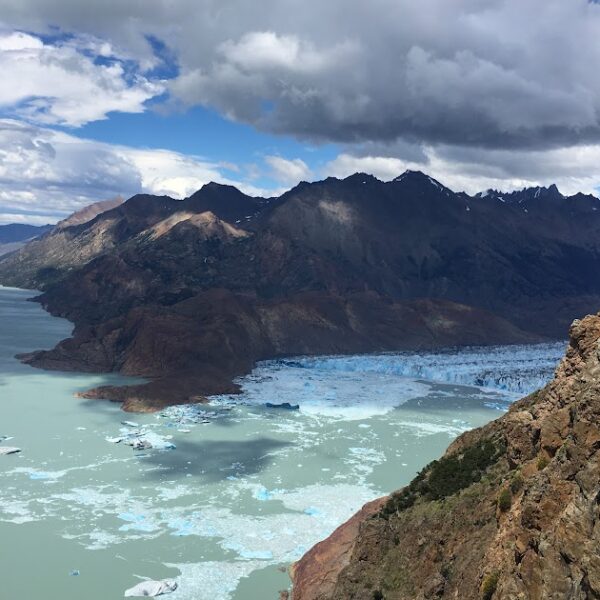
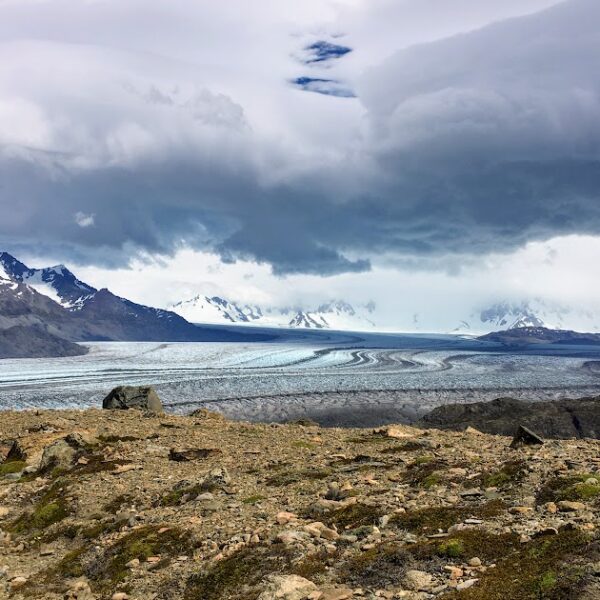
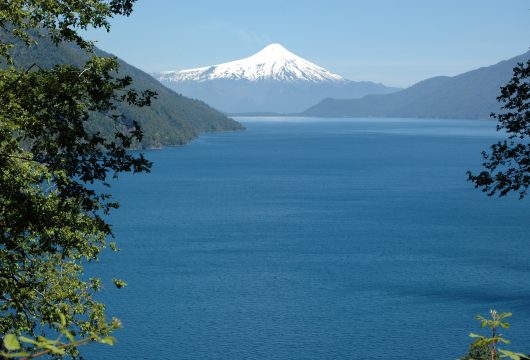

 a Group Tour
a Group Tour 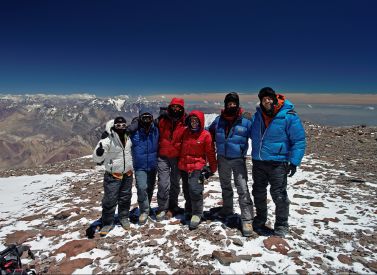
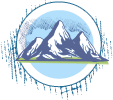
 a Tailor Made Tour
a Tailor Made Tour 